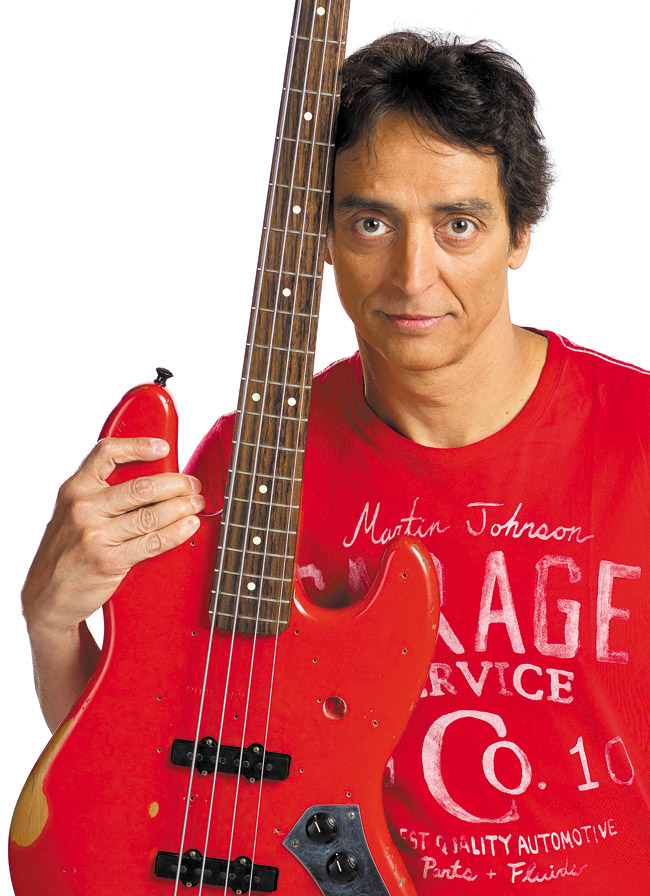Benny’s Back
Local boy Benny Rietveld takes a break from pounding out bass lines with Carlos Santana this week to reunite with members of Topaz, a late-’70s, early-’80s-ish jazz-fusion outfit, for a one night-only performance in Honolulu.
The improvisational notes start dropping at 7 p.m. Thursday at Crossroads at Hawaiian Brian’s. Tickets cost $20 for general admission, $15 for seniors (65 and over) and free for children under the age of 12.
For Rietveld — Santana’s current bassist and musical director, and one of the most sought-after musicians in the professional circuit since his recording and touring stints with percussionist Sheila E. and jazz legend Miles Davis began in the 1980s — the opportunity to trade licks with former high school buddies and a mentor was simply too good to pass up.
“It’s been like 30 years since we all last played together, ” says Rietveld, who will share the stage with two McKinley High alums, drummer Noel Okimoto and saxophonist Allen Won, keyboardist Carl Wakeland and the evening’s special guest performer, legendary saxophonist and multireedist Gabe Baltazar Jr. “We’ve been talking about doing this for a long time — getting together and paying tribute to all of our mentors, including Gabe, who back then gave a few young guys a shot to be in his quartet. It was great tutelage for us. So when we had the chance to play together again, we were like, ‘OK, let’s do this!”
The band will cover many of the same songs it played back in the day, when jazz-fusion was a relatively new genre and its members gigged all over town, including at iconic Honolulu locations such as the Cavalier and La Mancha. Still, Rietveld notes there may be a few music surprises for guests. “We’ll do an original song from Noel that was kind of a minor hit on one of Gabe’s albums,” says the bassist, who was born in Utrecht, Netherlands, but relocated to Kaimuki with his parents when he was a toddler.
Rietveld, who spends time these days commuting between homes in Los Angeles and New York City, relocated to the West Coast in the early ’80s, soon after Topaz disbanded. He quickly found success as a trusted bass player among veteran musicians because he understood “how to prop others up while maintaining a solid groove.”
“I learned early on not to get in the other musicians’ way and to listen to everyone on the bandstand,” says Rietveld.
Here’s what else this homegrown bassist told Musical Notes:
MN: I suppose it was worth it leaving Hawaii to pursue musical opportunities elsewhere, right?
BR: Definitely. I had an epiphany of sorts back then that I needed to learn a lot more than what I then knew. A friend in San Francisco invited me to move over to the West Coast, telling me there were more opportunities there, and so I did, hooking up with a lot of local bands along the way, including percussionist Pete Escovedo, and writing and recording with Bonnie Hayes.
MN: After getting the touring gig with Sheila E. and the Prince organization, you were hired to work with Miles Davis first and later guitarist Carlos Santana. How did this all happen?
BR: It was just one of those things where Miles asked Prince if he knew of any bass players. From what I understand, Prince said that Sheila had suggested me because I had already left her band the year before. Miles called me and I was like, yeah, of course I’ll join! That gig went on for a while and then one day I was in the studio with Miles recording someone else’s project, when I bumped into Carlos. He told me he was looking for a bassist and gave me his number. Since I was about to leave the Miles Davis band anyway, and thinking this was a sign-from-the-universe kind of thing, I decided to take Carlos up on his offer. I’ve been with him ever since.
GOOD-KINE NOTE:
While Topaz’s members had already gone their separate ways by the summer of ’84, another “band” was just coming into existence at that time — and oh how this group’s members would produce a melody of sweet notes for Oahu’s residents. I’m talking about the original gang at MidWeek — hard-working, dedicated types who began producing and delivering a unique, mass-coverage newspaper that celebrated all the good people do. A few of them are still around, most notably, publisher Ron Nagasawa and regional editor Carol Chang, and they’ve continued to share their sage advice and strong work habits with the current generation of MidWeekers. We don’t hand out Grammy Awards in these parts, but if we did, they would be absolute shoo-ins for “Best Performance,” “Lifetime Achievement” and “Legend” honors. I wasn’t around for the start-up of this newspaper, but was fortunate enough to have served as its first managing editor, spending many days and nights laboring alongside such fine people, and picking up a few good habits along the way. After leaving the business to chase other frontiers a decade ago, I didn’t plan on ever coming back. But four years and a month ago, I did just that — and came “home.” Today as the newspaper’s special sections editor and music columnist, I feel immense pride in knowing I’m a part of this team. Thirty years is certainly a long time to being doing anything, and doing it well. But time has a way of passing sweetly when you know you’ve got good people at your side.






